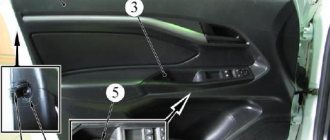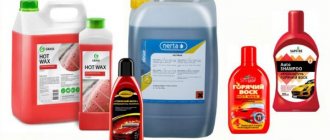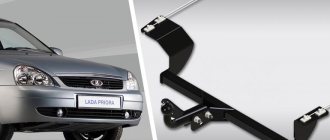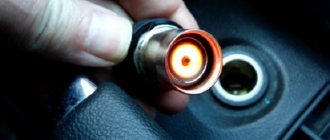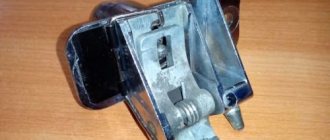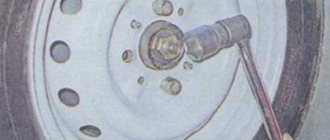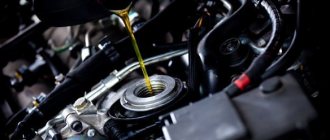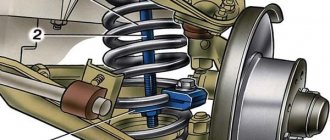Wheel arches are the most exposed part of the car to mechanical stress. Nevertheless, some motorists are confident that the factory protection can fully cope with its responsibilities. Others are absolutely convinced of the need to take additional measures to protect the metal of the wheel arches, otherwise in a few years, as a result of driving on domestic roads, they will receive damage “incompatible with life.”
Let's figure out which one is right.
Wheel arch protection: why is it needed?
Stones and other objects flying out from under the wheels, driven by centrifugal force, rush upward, where they are met by the inner surface of the wheel arch. As you know, water wears away stones. In this sense, metal is a more pliable material for stone. But it's not only that. Modern anti-corrosion treatment copes quite well with such mechanical stress, while simultaneously protecting the metal from corrosion.
But if chemical factors come into play (remember winter reagents for ice), such protection turns out to be powerless. That's what fender liners are for.
Many automakers install their own protection on wheel arches. This is usually a thin plastic that breaks down over time under the influence of gravel, sand, screenings, salt and other factors. So the question of why you need to install fender liners on a car is still quite relevant, especially for older cars. Car owners just need to carefully monitor the condition of the inner cavity of the wheel arches (as well as the bottom), and if it gives rise to concern, take measures to avoid further destruction.
There is no better way to do this than installing additional protection. Therefore, let's look at what fender liners are, what they are like, and how you can install them yourself without resorting to the help of car services.
Tags: installing factory fender liners without screws and extra holes in the body
Comments 56
What perversions did you see?
the type of fender liner itself
I also set these for myself in the summer at 9k)
Somehow I found where to buy them)
Hi, what kind of fender liners are these?
Hello, the wheel arch liners from the VAZ 2114 are factory.
the plasticine will melt in the summer, cover it with a transparent silicone sealant, the fender liners are shaped like foreign or something, to me they’re like the factory fender liners for 2108, my wings are plastic, I don’t care about the cutter
I bet regular plasticine will melt, but auto plasticine will be just elastic
Wow, this is a useful post. I’ve had these fender liners lying around for two years now, I tried them on once, they didn’t fit, I thought for a long time about how to install them. I'll take note. Thank you!
You're welcome, installation is very simple and quick. Of course you'll have to cut off the excess
Good job, but there is one BUT, will this plasticine fly off the first time you wash the car? In my rear, almost all the anti-corrosion protection in the arches was knocked off at the car wash.
Thank you. The plasticine will not fly off, it holds very tightly. Once upon a time it was smeared on my 9, drove for 5 years, did not fly off
Read more: How to make a slip on the spot
Good job, but there is one BUT, will this plasticine fly off the first time you wash the car? In my rear, almost all the anti-corrosion protection in the arches was knocked off at the car wash.
Don't worry, it won't fly off. I have a couple of holes in the door sealed with it, and it will be fine for almost a year now. At the car washes, even the spray paint applied to it didn’t come off =)
Do you need regular car plasticine or some special one? Does it harden or stay the same soft?
I had some kind of blue box lying in my garage with the inscription “Autoplastelin with a rye converter.” They all seem to be like that. No, it remains plastic for the entire time of use. Moreover, this crap was in my garage for at least 7 years; it was still used in my father’s seven.
ok topic, I already bought a car with these
Thank you. It’s good that I already bought with these
They also make cars from this plasticine! hahahaha))))
What really holds up well? Will it come off metal normally?
Plasticine do you mean?
I used plasticine to fill small gaps between the wing arch and the fender liner so that dirt and water would not get in. In fact, I did not use the plasticine to hold the fender liner, but it rubs off the metal perfectly.
first time I heard about these
I myself found out not long ago that such things exist.
I would like the discs to be unwelded
I respect competent work, but I would just like to add from my personal experience I bought a fresh four and it wasn’t even a year old and these factory fender liners were standing there, in general, I was riding until after washing I noticed that in the part where the open space, or rather where the fender liner does not cover, there is a dent and also about 1.5 cm of metal was torn apart and it was all due to a stone that jumped out from under the wheel! I spat on everything, removed them, removed the metal rupture, processed them and installed those that completely cover the entire space, naturally, having sealed everything, only instead of plasticine I used silicone! But thanks for the tip with plasticine, autumn will come, I’ll take pictures of everything and then I’ll use plasticine. I set the task that every year I will monitor what’s happening there! Good luck on the roads
Thank you very much, mutually. I’ll take note and monitor what’s happening under the fender liners.
Types of fender liner
There are several ways to protect car arches. Let's look at the most popular and widespread of them:
- plastic fender liners. Lockers made of soft plastic replaced metal fender liners, which were very common in Soviet times. They had a good resource, but were heavy and inconvenient to install. Plastic products have lost these shortcomings, being practically inferior to them in terms of mechanical strength. They are much more elastic, lighter, characterized by high wear resistance, and easy to install. In retail there are products of various shapes, designed for almost all domestic models and most foreign cars. And the cost of plastic is much lower than metal. Their main drawback is the need for fastening to metal using self-tapping screws - even if this area is treated with an anti-corrosion compound, over time this is where a rust spot can form;
- Fiberglass fender liners in their characteristics are not much different from plastic ones - their light weight, strength and immunity to temperature and atmospheric factors make them a good, albeit more expensive, alternative to plastic;
- liquid lockers have long become the de facto standard when applying an anti-corrosion/anti-gravel layer in a factory environment. You can create such an additional one yourself, using the appropriate liquid, of which there is an abundance in the retail chain. The main advantage of liquid lockers is the ease of processing any pre-cleaned surface, regardless of their geometry. The disadvantage is also quite obvious - the fragility of the coating (average service life is 2-3 years);
- armoring film is a type of metal protection that appeared relatively recently. However, in factory conditions the technology has already proven itself on the positive side; it is used to protect all body parts exposed to external influences: bumpers, sills, optical instrument lamps. The strength qualities of such films are no worse than plastic, plus they are transparent, that is, they do not spoil the appearance of the car. The only significant drawback is the complex application technology;
- fender liners made of ABS plastic have approximately the same set of pros and cons as regular polyethylene - with low weight and cost, they are not very durable, and also have low weather resistance. They are not recommended to be pressed too tightly against the arches due to the risk of cracks; the overall service life of such products is low;
- Aluminum lockers, as well as galvanized ones, are practically not used today. Despite their high mechanical strength, they have a number of disadvantages (the need to use a rubber gasket, the risk of bursting at the fastening point or being subject to deformation).
Fastening designs for automobile fender liners
Depending on the material and design features of the fender liners, additional fixation elements are required. Models made of ABC and fiberglass have increased rigidity; this feature does not allow them to be fixed absolutely motionless over the entire plane. Otherwise they will burst due to vibration.
Fastening designs differ depending on the manufacturer:
- CIS countries. When installing fender liners on domestic cars, self-tapping screws are used.
- European manufacturers use all types of fasteners.
- Asian manufacturers produce two types of fastening systems - clips and self-tapping screws.
- American automobile factories prefer to use plastic clips.
Fastening elements
Only liquid lockers do not require the use of fasteners. All their other varieties need to be fixed and secured somehow. Different manufacturers handle this differently. Thus, domestic car factories prefer to use self-tapping screws, while Asian car manufacturers use both self-tapping screws and clips. In the USA, plastic clips are mainly used, while in the Old World many types of fasteners are used.
Let's look at all the common ways to attach fender liners:
- clips are used to attach not only the fender liner, but also other parts of the body and interior (for example, trim). An alternative name for this type of fastener is a spring clamp. There is a reason for this name: fixation occurs due to the expansion of the cut part of the clip after its installation;
- latches, like clips, do not provide ideal fastening rigidity, but their main advantage is a non-traumatic installation method, used mainly for rigid types of fender liners (fiberglass, ABS plastic);
- self-tapping screws are the easiest to use, have a longer service life, but leave behind holes in the body part. It is recommended to use only galvanized products, and treat the fastening area with an anti-corrosion compound;
- Pistons can also be called a common and universal method of fastening automotive parts. The fixing ability remains high even in cases where the piston does not completely enter the hole;
- bolt + nut – a type of threaded fastening, characterized by high reliability of the connection and its low aesthetics. Requires anti-corrosion treatment.
Manufacturers and prices
Here is an approximate list of manufacturers who have lockers for Duster:
- Russian Artel (full set for 4 wheels - 4,700 rubles);
- Novline (4 wheel covers with sound insulation for RUB 4,100);
- PT Group (full set for a car - 4,270 rubles);
- TOTEM (sold separately, the set costs 4,800 rubles);
- AutoFamily (the most budget-friendly of those presented here, for a complete set 2,900 rubles).
From these manufacturers you can purchase components for Renault Duster, including wheel arch liners, at reasonable prices. However, this list is far from complete; when purchasing, you need to check the exact configuration and model of lockers, so as not to be mistaken in compatibility with the car.
Noise insulation
Wheel arches, along with the engine compartment, are one of the most accessible places in terms of penetration of external noise into the cabin. Usually, the sound insulation of the engine compartment is done at a good level, so the sounds of a running engine practically do not reach the inside of the car. Another thing is the arches, which perfectly convey the acoustics of the tires. So, along with installing anti-corrosion and anti-gravel protection, you should also think about additional sound insulation. There is also a considerable selection of means and methods, from liquid materials to special sealants. You can also purchase fender liners with a sound-absorbing coating already applied.
Advice from experienced drivers
- To eliminate the relief discrepancy, during installation, individual sections of the plastic are deformed by heating them with a high-temperature hair dryer. If the fastening is done correctly, the tire should not touch the wheel arch protection even at maximum wheel inversion.
- If the area of the wheel arches is already rusty, then after cleaning it needs to be primed with anti-corrosion agents, for example “ML”, “Movil”. The composition protects exposed metal in holes from the corrosion process. For the same purpose, during installation, screws should be screwed in, having previously treated them with sealant.
Read more: Zhirinovsky’s voice for Yandex
Most products have point protrusions - this greatly simplifies installation, which can be done without distortions. If the fasteners are not performed correctly, some areas of the body will remain unprotected. According to reviews from consumers and sellers, the warranty on fender liners corresponds to their shelf life - 5-8 years.
Hi all.
Denis and I decided to install fender liners from the 14 for me. I couldn’t find any information about the installation on the Internet.
I decided to share my personal experience with you, maybe it will be useful to someone.
Today Denis and I completed the installation of fender liners on my car.
We installed standard wheel arch liners from 14 in 2109. There seemed to be no difficulties with the installation. The installation took three evenings for two hours. First evening.
I went to the car wash, washed the whole car, special emphasis was placed on washing under the wings. After washing, I went to put the car in the garage. That same evening I removed the front wings. To wash off any remaining dirt, dry everything. Apply a little mastic in the right places if required.
What is needed to install the fender liner
It all depends on the type of lockers used. So you need to start with their selection. In the retail chain they are presented in sets, but you can purchase fender liners separately if necessary. Original products are expensive, but they are easy to install in a seat; in this case, there are no compatibility problems, unlike analogues.
What you will need besides lockers:
- soundproofing material. The most common is vibroplast, which, in addition to soundproofing properties, will protect the body from moisture;
- material for anti-corrosion treatment of those places where fasteners are used or where the locker comes into contact with the body;
- construction hair dryer - used to cover the arch with vibroplast, to preheat some types of lockers, especially non-original ones;
- fastening the fender liners (screws, clips, latches). Using clips, you can attach lockers to plastic bumpers, self-tapping screws are used for fastening to metal body parts.
How to install rear fenders correctly
Installing a rear fender liner on a Renault Logan requires preparatory work. You will also need a certain set of tools and materials:
- crosshead screwdriver;
- jack;
- "balloon" key;
- rags or rags;
- clean water and detergent solution;
- fender liners and a set of fastening screws;
- vibroplast 4–5 millimeters thick;
- 2 cans of anti-corrosion compound.
Installing or replacing rear plastic fender liners is carried out as follows:
- The car is placed on supports and jacked up.
- The rear wheel is removed.
- Carefully unscrew the rear mudguard (attached with 3 bolts).
- The wheel arch is thoroughly washed with soapy water and a cleaning solution, then rinsed with clean water.
- The arch is wiped dry with a rag.
- The metal is treated with an anti-corrosion coating.
- If there are traces of rust, it should be removed mechanically before processing.
- Then the wheel arch is glued with vibroplast. This material is necessary to ensure complete sound insulation.
- A new fender liner is installed on top of the vibroplast; it is attached to the standard places with self-tapping screws.
- The wheel is replaced and the car is removed from the jack.
The rest of the car's fender liners, including the front ones, are installed in a similar way.
Installing rear fender liners on a Duster is fundamentally no different, and the work requires a similar set of tools and materials. These works can be easily carried out independently, and replacing all the fender liners will take no more than 2-3 hours.
Do-it-yourself fender liner installation algorithm
Installing lockers on the front arches is in most cases a simpler operation. The reason is simple - there are more opportunities to install fender liners without screws. We will try to describe how to do this. The task is simplified by the ability to attach a plastic bumper to the side edge, which on most modern models is adjacent to the wheel opening. It is clear that the risk of corrosion in this area is reduced to zero. In addition, lockers can be installed in existing grooves; in this case, additional fixation is often not needed at all. Another simple option is to attach the fender liners to the mudguards; in this case, self-tapping screws can be used in the area of the arch pillar, where the metal of the body is well protected.
Installing rear lockers is more difficult:
- you need to start by trying on the fender liner and trimming the protruding parts;
- then you should prepare the metal surface (free it from dirt and rust) and immediately treat it with mastic or another similar substance;
- Now it’s time to start installing the locker. If you cannot do without self-tapping screws, try to minimize their number without compromising the strength of the connection;
- try to use plastic fasteners (clips, pistons, latches) where possible;
- If you have doubts about reliable fixation, you can carefully glue the fastening points.
Over time, the lockers, which initially do not have a gap with the body, may move away, so this must be monitored during operation of the car. If such places are discovered, it is necessary to urgently take measures aimed at eliminating the deficiencies. Otherwise, the cracks will inevitably become a place for the accumulation of dirt and moisture, that is, a source of corrosion.
Let's sum it up
Today, motorists are bombarded with constant advertising related to various methods of car protection, which are not always quite effective. It should be remembered that there is a basic set of protection against the spread of corrosion, and this is what you should use in your car. Anything that turns out to be excessive will ultimately just cost you money and significantly increase the overall cost of running the car. Fender liners are necessary and have not become the subject of popular advertising because they are quite cheap.
Otherwise, various methods of reducing sound effects when driving, the mythical insulation of wheel arches and other important manifestations of various methods of equipping a car with additional advantages end without results. You should not waste a lot of money on methods of improving a car that do not work and do not provide any results or practical benefits. Choose high-quality fender liners, install them using good fasteners and enjoy a pleasant ride. Have you installed wheel arch liners on your car?
Now you can proceed directly to the installation:
- The wheel is removed and the car is jacked up.
- First, the wheel arches are washed with soap and then with clean water and wiped dry.
- The three nuts on the standard fender liner are unscrewed; the locker itself is not removed.
- The nuts of the mudguard are unscrewed and it is dismantled.
- The purchased locker is installed on three self-tapping bolts.
- The mudguard is restored to its position.
- The fender liner is fixed, the nuts are tightened.
- The protective film is removed, the gap is minimized, and the reliability of the fastenings is checked again.
- The wheel is put in place.
Installation must be done very carefully so as not to scratch the car bumper when inserting the trim. Similar actions must be carried out with all wheels.
On average, the replacement job can take about three hours.
Installation must be carried out in the warm season at temperatures from +19 to +25 degrees; if installation is done in winter, then the parts must be kept in a warm room for approximately four hours before installing them. It is not recommended to use physical force during installation - this can lead to severe damage to the fenders or bumper. After installing the lockers, the car should not be exposed to moisture for 24 hours.

